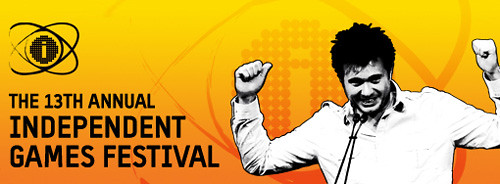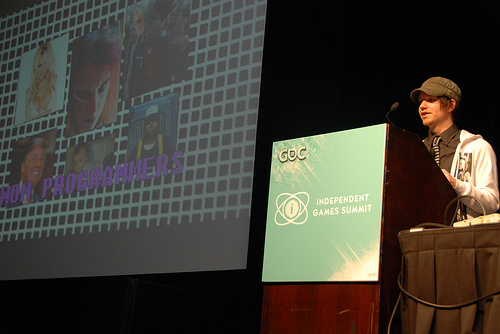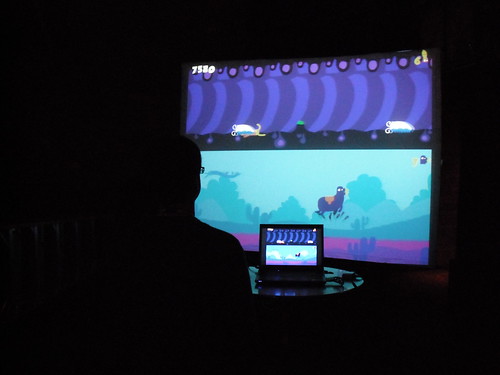Posts from ‘IGF / GDC’ Category
IGF 2011 Entrants Announced
By: Derek Yu
On: October 21st, 2010

The entrants for the Independent Games Festival 2011 have been announced! This year there are a whopping 391 entries. As a fun reference, the number of entries for 2010-2007 were 306, 224, 173, and 143, respectively. Exciting stuff.
Jump straight to the list here.
IGF 2011 Open for Entries, Changes Judging Process
By: Paul Eres
On: June 28th, 2010

The IGF 2011, also known perhaps as the cactus IGF, is now open for entries. Here’s the news post about it by Simon Carless, and here’s a letter from the new IGF chairman Brandon Boyer about the changes.
Instead of rating games with scores in each category, they’re going with juries, debate, and a nominations system, similar to how the Nuovo award finalists were chosen in IGF 2010. It’ll be interesting to see the results of this new process in the form of the finalists and winners chosen by it.
They also are now allowing mobile games into the main competition: previously iPhone games (etc.) were ineligible for the grand prize. And they are increasing the total number of finalists for the Nuovo award from five to eight.
Brandon Boyer Named IGF Chairman
By: Derek Yu
On: May 12th, 2010
Brandon Boyer, who you might (should!) recognize as the games editor for Boing Boing and the awesome Offworld, has been named Chairman of the Independent Games Festival. Simon Carless, the previous Chairman (who has done a superhuman job, I might add), will still help out on the IGF/IGS organizing committee, along with Matthew Wegner and Steve Swink. You can read the full announcement on the IGF website.
Great, now I’m already excited for next year’s IGF.
IGS 2010: Fantastic Contraption Postmortem
By: Brandon McCartin (BMcC)
On: April 16th, 2010

Colin Northway Speaks, Has Beard (photo by Chrissy “Nava” Chubala)
Colin Northway gave a fairly business-oriented postmortem of his game Fantastic Contraption at this year’s Independent Games Summit called (no big surprise here) Postmortem: The Design & Business Behind Fantastic Contraption. He had actually given this talk previously at the last GDC Austin, so I can link you to Brandon Boyer’s detailed Offworld coverage of that session rather than typing up all these darn notes myself! In short: Flash is good, Box2D is great, and anyone can create and publish a successful game all by themselves. (Though, backup from Andy Moore certainly doesn’t hurt!)
Okay, it was a bit more in depth than that. Read on, if you dare!
Fantastic Contraption was conceived one night when Colin awoke and scribbled down a note beginning with “Cool Shit Idea.” The majority of the game was done within a few weeks, using only notepad and a command line compiler. A bunch of user (i.e., family) testing and website work later, the game was released. After going away for a weekend, Colin returned to find the game had blown up on StumbleUpon, crushing the servers. “It was a good problem to have, but there are no good problems, only problems.” Needless to say, the game quickly became a success. Andy Moore was soon brought in to manage the rapidly growing fan community.
Apart from the stats and such, what I really took away from this talk were some great messages for independent (and wannabe independent) game developers in general. Colin built a solid game that seemed to perpetuate itself, putting no resources into press, portals, publishers, ads, or anything. Here are some of the more quotable quotes:
“Box2D is the Fire Flower of game development.” (He even kicked back some of the profit from the game to Erin Catto, which is awesome.)
“Money is dumb and lonely and just wants to be with other money.” Once the game took off, people started coming to him. But “pay attention to the slime factor” when dealing with the business end of things. (Colin was at one point offered a couple hundred bucks for the source of and full rights to the game.)
“Go into the wilderness” when deciding what to make, “make what you want, not what people say” — you will find success with your own creativity. Sometimes “everyone says no” but “you don’t need permission to make a really good game, or a successful one.” “There are no gatekeepers.” (This is my favorite!)
Embrace social networking; you don’t need to conquer it to use it. And “close the information gap, talk to other indies.”
Also, Colin casually said “fantastic” (outside the context of the game’s title) like fifty times. I wonder if he noticed. :)
All in all, pretty inspiring stuff!
IGS 2010: Abusing Your Players Just For Fun
By: Brandon McCartin (BMcC)
On: April 13th, 2010

Photo by non-programmer Rebekah Saltsman
I was planning to simply summarize the various IGS sessions this year, but instead wrote up every single note I had for my previous post. Today I shall exercise some restraint!
IGF Nuovo Award winner and indie mastermind Cactus’ first talk this year, Abusing Your Players Just For Fun, was ostensibly about designing games with obfuscated interactions, bizarre themes, trippy visuals, a high level of difficulty— the kind of stuff Cactus is known for— but really, to me, seemed more about encouraging people who would otherwise not develop games to try, about the desire to see an even greater variety of creative output from the indie games sphere. (I’m sure we’ve all wondered at some point what types of games Bowie might make! Or that baby.)
The session opened with a legitimate seizure warning (though, his talk last year was probably more dangerous in that regard) and, for the most part, he discussed various artists in other fields, like film and music, who bring a singular, unique creative vision to their work. He even stopped for a spell to show this scene from David Lynch’s Lost Highway.
But that’s not to say game designers didn’t get their due! Cactus went on to show the work of a few indies that inspire him, “punk rock” game developers as he called them: Matt “TheAnemic” Aldrige, creator of the surreal La La Land series of games (and most recently Uin); Mark “”http://messhof.com/news/" title=“Messhof’s Site”>Messhof" Essen, in particular his games Punishment, Flywrench, and Randy Balma: Municipal Abortionist; the multi-talented Jph Wacheski; and even Jon Blow. (He probably did, but I would also have to point to Stephen “”http://www.increpare.com/" title=“increpare games (Stephen Lavelle”>increpare" Lavelle and his ever growing portfolio of mind-bending works!)
If you’d like to read a description of the session by someone who, you know, actually knows how to write, I recommend this post Scott Sharkey made to his 1UP blog— he really nails it!
IGS 2010: Indie Fund Explained
By: Brandon McCartin (BMcC)
On: March 26th, 2010

Photo courtesy of Rebekah Saltsman
The 2010 Independent Games Summit kicked off this year with a talk from Ron Carmel (of 2D Boy fame) called Indies and Publishers: Fixing a System that Never Worked, further clarifying the recently announced Indie Fund — a new investment/funding alternative created by successful indie developers for indie developers. The Fund has secretly been in action a while now, but is still not yet fully public, so this session bridged the gap somewhat between its reveal a few weeks ago and eventual open submissions.
I’ll summarize the talk (and the Q/A session) after the jump, but if you want all the details, plus high resolution versions of David Hellman‘s dope slides, head over to Brandon Boyer’s excellent article on Offworld (Boing Boing, whatever).
The Problem, as Ron put it, is mainstream publishers still treat indie development teams the same as they would any other. Old habits inherited from the retail days are still alive, not taking into account the streamlined, iterative way in which most indie games are made, nor their low budget. What this means is publishers wind up taking too big of a risk up front, and taking too much in return, effectively turning the independent developers into “tenant farmers.” Despite the fact that digital distribution means smaller games with zero manufacturing costs, and smaller teams that don’t need to make as much money, the system in place is largely unchanged from AAA game publishing. It’s generally inefficient and keeps the developer in the dark, but there isn’t a better alternative.
As an example, Ron described what he and Kyle went through trying to bring World of Goo to Games for Windows Live. The game got passed through lawyers, supervisors, engineers, QA teams, and various other managers for months and months before being approved. But when they brought the game to Steam (an admittedly more established service) the process took only a few days.
Ron defined publishing with an equation: Publishing = Funding + Distribution. But with the wide variety of distribution channels available to indies today, he concluded that traditional publishers aren’t needed at all. All that’s needed is funding. So the question became, “How do we do for publishing what Steam did for distribution?” The answer: Indie Fund.
He then went on to name some of the objectives of Indie Fund:
– A transparent, faster submission process
– A clear, publicly available deal
– A direct line of communication with the developer
– A flexible development setup for the developer
(no design docs, no milestones, just periodic builds with change lists)
– No IP ownership, no creative control over the developer
– No editorial work, putting trust in the developer
This concluded the talk. A brief Question and Answer session followed (which I will continue to heavily paraphrase):
Q: How big is the fund?
A: Size doesn’t matter. Finding the right games matters; the money will come.
Q: What about the role traditional publishers play in marketing?
A: It’s possible they help, but I haven’t seen conclusive evidence of them making a difference.
Q: When will the submission process open?
A: Currently it’s through word of mouth. We’re still ironing things out, waiting for results, etc.
Q: Are traditional publishers needed to reach all platforms?
A: We’re not handling that part of the business. But making one deal usually opens the door for others.
Q: Is Indie Fund similar to Y Combinator?
A: They seem to provide less funding and much earlier. Indie Fund will be more conservative at first, providing a significant amount of funding to more complete games.
Q: Will Indie Fund provide the developer with resources? Will you take royalties?
A: This isn’t our full time job. We won’t be doing these things. The developer should remain independent.
GDC 2010: Please Finish Your Game
By: Derek Yu
On: March 24th, 2010
The inimitable Chris Hecker ranted at GDC this year (Chris worked on Spore but is now indie). His rant, titled “Please Finish Your Game”, addresses the issue of development time in the mainstream and indie communities. Specifically, he asks developers to pursue good ideas to their “logical and aesthetic extent”.
Chris elaborates on his rant here, and has added an email exchange he had with cactus about it afterwards (cactus is featured prominently in the rant).
GDC 2010: San Fran & Back Again
By: Brandon McCartin (BMcC)
On: March 23rd, 2010

Embarrassing picture making me look like more of a derelict than I truly am courtesy of Chrissy Chubala
The 2010 Game Developers Conference has come and gone.
GDC is essentially the start of the year for me. It’s more of a personal landmark than Christmas or my birthday. When I get home, that’s my January 1st. This year, like every year, was profoundly inspiring, motivating, enlightening, exciting, and everything in between. Just being around so many people who decide to do the same crazy thing you do, who have such passion, is almost magical. (Especially after months of solitary work!)
Yet, GDC is also different each year. The indie community keeps growing and changing. This year there were so many new faces, more than ever, so many surprises, and an overall feeling of… something I can’t put my finger on, but that’s good! It was certainly the best year yet. (On the other hand, what year wasn’t?) Here’s to seeing even more indies next year!
I’ve got plenty of stories to tell, but the front page isn’t really the place for it. Instead I’m going to put down my coverage of The Independent Games Summit already. Sitting at each session, furiously scribbling notes, I thought, “Yeah, I’m on top of it this year!” Of course the real journalists were typing right into blog posts, or Twitter, or whatever fancy new thing they’ve got on their fancy-pants laptops. (I would say something here about me being “too indie” and so on, but the truth is I was woefully unprepared for everything, as always.)
So, in lieu of most (if not all) of the sessions being posted to death already, I’ll provide summaries, plus my own personal, first-hand impressions of everything I saw, along with links to some of the better write-ups online. If you’ve seen enough already, or just don’t care, I apologize, carry on. But if I reach just one child’s heart… it’s worth it.
GDC 2010: No More Giggles
By: Derek Yu
On: March 19th, 2010
A week after Tommy Refenes (Super Meat Boy) declared the Apple App Store to be the Tiger Electronics handheld of this generation (part of the Indie Game Maker Rant session), Apple has removed his zit-popping game Zits & Giggles from the App Store. As an experiment, Tommy raised the price tier every time someone bought Zits & Giggles, with people eventually buying the game for $300. He concluded that the iPhone audience was not primarily gamers and that games like Street Fighter, Assassin’s Creed, and Mega Man, which play poorly on the iPhone (like games ported to the Tiger Electronic Handheld), are nothing more than a way to sell a brand.
Apple has not responded, so it’s unclear whether they are retaliating against Tommy’s rant or his price-raising experiment. Or both.
GDC 2010: The Games of Gamma IV
By: Derek Yu
On: March 17th, 2010
Gamma IV marked a nice interlude at the midpoint of GDC (following the Independent Games Summit). I’ve never been before, but I left feeling more than ever that games are work great for shows, galleries, and parties when they’re created for those spaces. Here are the six games that won the chance to be in the show:
4Fourths – That’s got to be the sickest trailer for a game ever (by John Likens). Anyway, Mike and Greg’s 4Fourths is a 4-player game where teams of two cooperate to destroy nukes before they fall onto a city. In each team, one person controls the thrusters and one person controls the laser. You can also shoot the other team, which is easy to do accidentally or on purpose. Great fun, and it looked fantastic projected big.
Faraway – Far and away (h’yuk) the game I played most at Gamma IV, Faraway is an addictive highscore game from Steph Thirion, who created Eliss for the iPhone. Like Eliss, Faraway has a great minimalistic audio-visual design. The game, which has you playing a comet trying to make constellations, requires a lot of skill and practice. You can be seriously good at this game, as was evidenced by Colin Northway’s “constellation domination” throughout the conference. I wish I was playing it right now!
Poto & Cabenga – There’s no video for Honeyslug‘s Poto & Cabenga, unfortunately. In this game, you control both Poto & Cabenga at the same time, with one button. The way it’s handled is really clever (you can read about it in more detail here), and the character designs are great. I can’t wait until they release it on the internets.
B.U.T.T.O.N. – I had no clue what B.U.T.T.O.N. was about when I started playing, so I was holding a drink in one hand with the notion that I could play a one-button game with the other. Then the screen instructed all the players to do five push-ups. Thankfully, being me, I did twenty push-ups, finished my drink (whiskey and snake’s blood), and still won (sorry, there were no witnesses!). You can’t tell from the above video, but the game actually has pretty nice graphics! Fun party game.
GAMMA IV – The Game – IGF Nuovo Award Winner cactus released a really fun, trippy Gamma game, aptly titled Gamma IV – The Game. It was projected behind the DJ, which was a good idea. It will make you think of swastikas and then you will have a seizure.
Silent Skies – I didn’t get a chance to try Michael Todd’s Silent Skies, unfortunately. But I enjoyed watching the planes do loop de loops from afar.
None of these games are playable as of writing, but a lot of the games that didn’t make it are. There were around 150 entries this year, so plenty of great ones didn’t make the cut. You can check them out at the Gamma IV forums.



